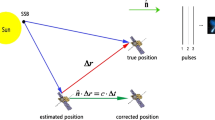Abstract
The basic principle of pulsar timing model was introduced, and the general relativistic corrections were analyzed when pulse time of arrival (TOA) was transferred to coordinate TOA at the Solar System Barycentre. Based on the shifting, an iterative method of autonomous position determination for spacecraft was developed. Accordingly, the linear form of the position offset equation was evolved. Using the initial estimated value of spacecraft’s position as the input of pulsar timing equation, through calculation of the offset between measured or transferred and predicted TOA, the position offset can be solved by Least Squares. At last, the main error sources including modeling error and parameters error were discussed.
Similar content being viewed by others
References
Joseph H, Taylor J R. Millisecond pulsars: Nature’s most stable clocks. Proc IEEE, 1991, 79(7): 1054–1062[DOI]
Moyer T D. Formulation for Observed and Computed Values of Deep Space Network Data Types. California: JPL Publication, 2000. 8–9
Backer D C, Hellings R W. Pulsar timing and general relativity. Annu Rev Astron Astrophy, 1986, 24: 537–575[DOI]
Martin C F, Torrence M H, Misner C W. Relativistic effects on an earth-orbiting satellite in the barycenter coordinate system. J Geophy Res, 1985, 90(B1): 9403–9410[DOI]
Lorimer D R, Kramer M. Handbook of Pulsar Astronomy. Cambridge: Cambridge University Press, 2005. 205
Hotan A W. High-Precision Observations of Relativistic Binary and Millisecond Pulsars. Doctoral Dissertation. Melbourne: Swinburne University of Technology, 2006. 27–29
Sheikh S I, Pines D J. Spacecraft navigation using x-ray pulsars. J Guid Contr Dyn, 2006, 29(1): 49–61[DOI]
Hellings R W. Relativistic effects in astronomical timing measurements. Astron J, 1986, 91(3): 650–659[DOI]
Thomas J B. Reformation of the relativistic conversion between coordinate time and atomic time. Astron J, 1975, 80(5): 405–411 [DOI]
Moyer T D. Transmation from proper time on earth to coordinate time in solar system barycentric space-time frame of reference, Part I. Celestl Mech, 1981, 23: 33–56[DOI]
Moyer T D. Transmation from proper time on earth to coordinate time in solar system barycentric space-time frame of reference, Part II. Celest Mech, 1981, 23: 57–68[DOI]
Taylor J H, Weisberg J M. Further experimental tests of relativistic gravity using the binary pulsar PSR, 1913+16. Astrophys J, 1989, 345: 434–450[DOI]
Shapiro I I. Fourth test of general relativity. Phys Rev Lett, 1964, 13(26): 163–174
Edwards R T, Hobbs G B, Manchaester R N. Tempo2, a new pulsar timing package: II. The timing model and precision estimates. Mon Not Roy Astron Soc, 2006, 372: 1549–1574[DOI]
Nan R D. Five hundred meter aperture spherical radio telescope (FAST). Sci China Ser G-Phys Mech Astron, 2006, 49: 129–148 [DOI]
Author information
Authors and Affiliations
Corresponding author
Additional information
Supported by the National Defence Laboratory Foundation of China (Grant No. 9140C3601010901) and Science Foundation of Shaanxi Province (Grant No. 2007F12) and the Technology Specialism Foundation of Shaanxi Education Department of Shaanxi Province (Grant No. 07JK332), and the Innovative Research Plan of Xi’an University of Technology (Grant No. 105-210714)
Rights and permissions
About this article
Cite this article
Li, J., Ke, X. Study on autonomous navigation based on pulsar timing model. Sci. China Ser. G-Phys. Mech. Astron. 52, 303–309 (2009). https://doi.org/10.1007/s11433-009-0015-3
Received:
Accepted:
Published:
Issue Date:
DOI: https://doi.org/10.1007/s11433-009-0015-3




